Additive fixatives - Study guides, Class notes & Summaries
Looking for the best study guides, study notes and summaries about Additive fixatives? On this page you'll find 34 study documents about Additive fixatives.
All 34 results
Sort by

-
Histotechnology - Tissue Fixation fully solved updated to pass
- Exam (elaborations) • 11 pages • 2023
- Available in package deal
-
- $17.99
- + learn more
Histotechnology - Tissue FixationAdditive fixatives Mercuric chloride Chromic acid Picric acid Formaldehyde Glutaraldehyde Osmium tetroxide Potassium dichromate Glyoxal Zinc salts Nonadditive fixatives Alcohols Acetone Acetic Acid Coagulant Fixatives Mercuric acid Chromic acid Picric acid Zinc salts Alcohols Acetone Acetic acid Noncoagulant Fixatives Formaldehyde Glutaraldehyde Osmium Tetroxide Potassium Dichromate Glyoxal Are coagulant fixatives addit...

-
Histotechnology - Tissue Fixation 2024 passed
- Exam (elaborations) • 11 pages • 2024
- Available in package deal
-
- $16.99
- + learn more
Histotechnology - Tissue FixationAdditive fixatives Mercuric chloride Chromic acid Picric acid Formaldehyde Glutaraldehyde Osmium tetroxide Potassium dichromate Glyoxal Zinc salts Nonadditive fixatives Alcohols Acetone Acetic Acid Coagulant Fixatives Mercuric acid Chromic acid Picric acid Zinc salts Alcohols Acetone Acetic acid Noncoagulant Fixatives Formaldehyde Glutaraldehyde Osmium Tetroxide Potassium Dichromate Glyoxal Are coagulant fixatives addit...
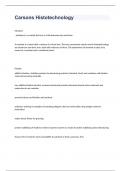
-
Carsons Histotechnology verified to pass 2023/2024 passed
- Exam (elaborations) • 111 pages • 2023
- Available in package deal
-
- $23.99
- + learn more
Carsons Mordant . substance’s or metals that act as a link between dye and tissue A mordant is a metal with a valency of at least two. The two commonest metals used in histotechnology are aluminum and ferric iron, both with valencies of three. The attachment of mordant to dyes is by means of a covalent and a coordinate bond. Fixative additive fixation- stabilizes proteins by denaturing proteins (chemical, heat) and combines with fixative molecule becoming insoluble non additive ...
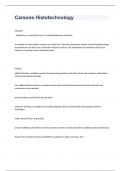
-
Carsons Histotechnology with 100% c0rrect answers 2024
- Exam (elaborations) • 111 pages • 2024
- Available in package deal
-
- $26.49
- + learn more
Carsons Mordant . substance’s or metals that act as a link between dye and tissue A mordant is a metal with a valency of at least two. The two commonest metals used in histotechnology are aluminum and ferric iron, both with valencies of three. The attachment of mordant to dyes is by means of a covalent and a coordinate bond. Fixative additive fixation- stabilizes proteins by denaturing proteins (chemical, heat) and combines with fixative molecule becoming insoluble non additive ...
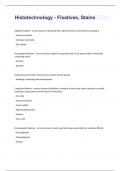
-
Histotechnology - Fixatives, Stains 2024 passed
- Exam (elaborations) • 10 pages • 2024
- Available in package deal
-
- $17.99
- + learn more
Histotechnology - Fixatives, Stains Additive fixatives - correct answers Chemically link, add themselves on to tissue and change it - Mercuric chloride - Chromium tetroxide - Zinc sulfate Nonadoptive fixatives - correct answers Organic compounds that act on tissue without chemically combining with it - Acetone - Alcohols Dissociate bound water molecules from tissue protein groups - Shrinkage, hardening with overexposure Coagulant fixatives - correct answers Establishes a network ...

-
Histotechnology - Tissue Fixation Question and answers already passed 2023/2024
- Exam (elaborations) • 11 pages • 2024
- Available in package deal
-
- $13.99
- + learn more
Histotechnology - Tissue Fixation Question and answers already passed 2023/2024 Additive fixatives Mercuric chloride Chromic acid Picric acid Formaldehyde Glutaraldehyde Osmium tetroxide Potassium dichromate Glyoxal Zinc salts Nonadditive fixatives Alcohols Acetone Acetic Acid Coagulant Fixatives Mercuric acid Chromic acid Picric acid Zinc salts Alcohols

-
BOC Study Guide Histotechnology 2nd edition Study Guide And Actual Answers.
- Exam (elaborations) • 10 pages • 2024
- Available in package deal
-
- $9.99
- + learn more
An example of an additive fixative is one that contains: - Answer picric acid Microscopic examination of an H&E stained section fixed in formalin shows marked nuclear bubbling. One most often sees this artifact if the specimen is processed following: - Answer incomplete fixation Microscopic evalution of H&E stained sections from a surgically removed small bowl specimen shows an absence of much of the epithelium in otherwise normal tissue. This most likely resulted from: - Answer d...
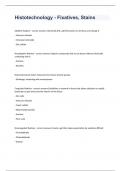
-
Histotechnology - Fixatives, Stains Question and answers rated A+ 2023/2024
- Exam (elaborations) • 10 pages • 2024
- Available in package deal
-
- $13.39
- + learn more
Histotechnology - Fixatives, Stains Question and answers rated A+ 2023/2024 Additive fixatives - correct answers Chemically link, add themselves on to tissue and change it - Mercuric chloride - Chromium tetroxide - Zinc sulfate Nonadoptive fixatives - correct answers Organic compounds that act on tissue without chemically combining with it - Acetone - Alcohols Dissociate bound water molecules from tissue protein groups - Shrinkage, hardening with overexposure Coagulant fixatives -...
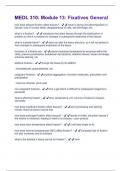
-
MEDL 310: Module 13: Fixatives General Latest Questions & Answers Verified 100% Correct
- Exam (elaborations) • 2 pages • 2024
- Available in package deal
-
- $8.39
- + learn more
how does delayed fixation affect tissues? - ️️result in drying and decomposition of tissues. loss of nuclear detail, disappearance of cells, cell shrinkage, etc. what is a fixative? - ️️substance that alters tissues through the stabilization of proteins so that it is resistant to changes in subsequent treatments of the tissues. what is a preservative? - ️️does not alter the tissue structure, so it will not protect it from changes in subsequent treatments of the tissue functions...
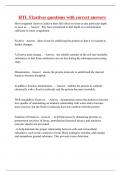
-
HTL Fixatives questions with correct answers
- Exam (elaborations) • 41 pages • 2023
- Available in package deal
-
- $16.99
- + learn more
Most coagulant fixatives achieve their full effect on tissue at any particular depth as soon as... - Answer they have penetrated to that depth at a concentration sufficient to cause coagulation. Fixative - Answer alters tissue by stabilizing the protein so that it is resistant to further changes. A fixative must change... - Answer the soluble contents of the cell into insoluble substances so that those substances are not lost during the subsequent processing steps. Denaturation - ...

That summary you just bought made someone very happy. Also get paid weekly? Sell your study resources on Stuvia! Discover all about earning on Stuvia


